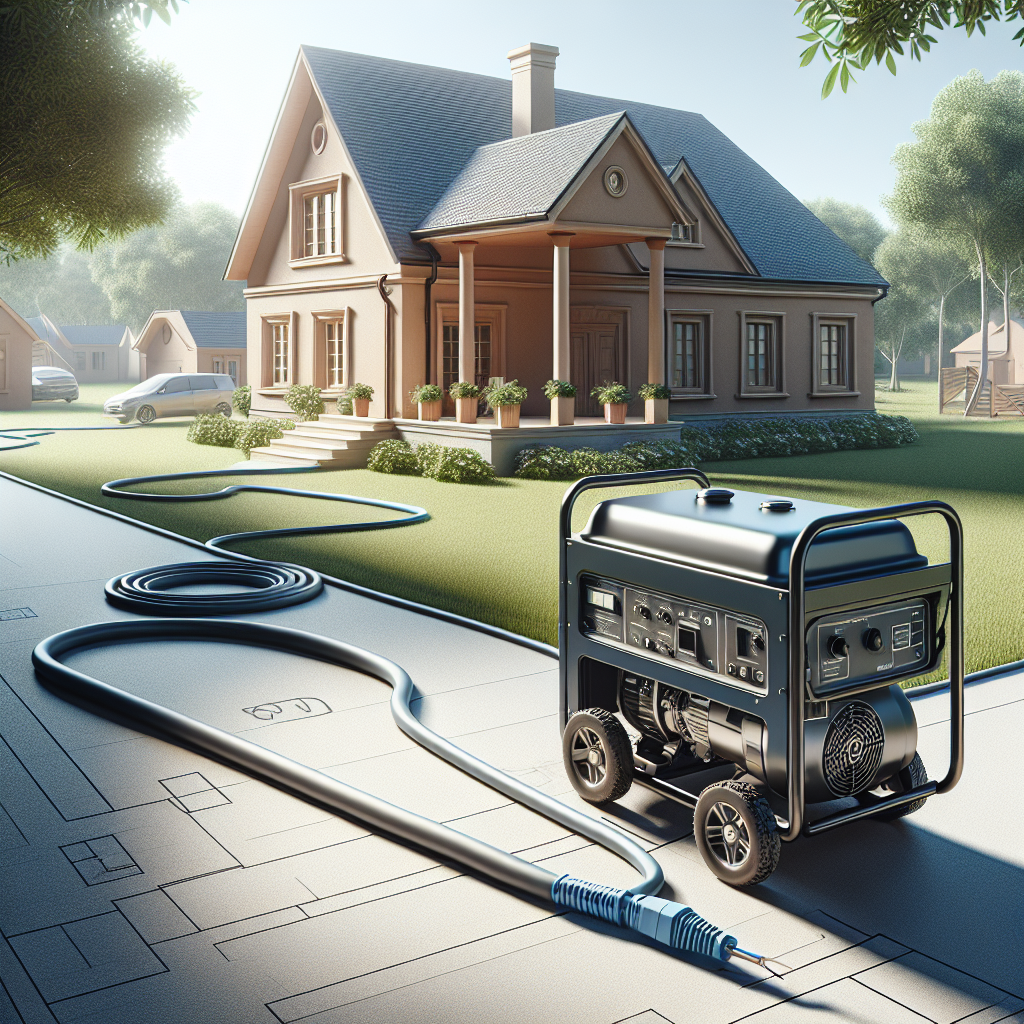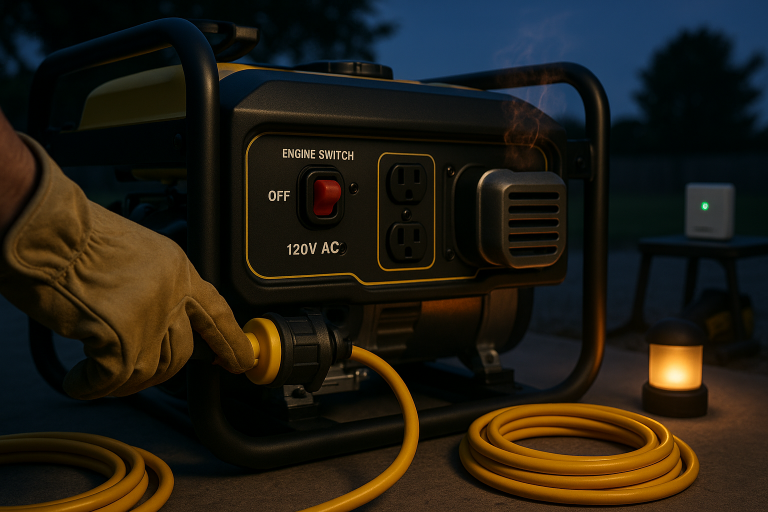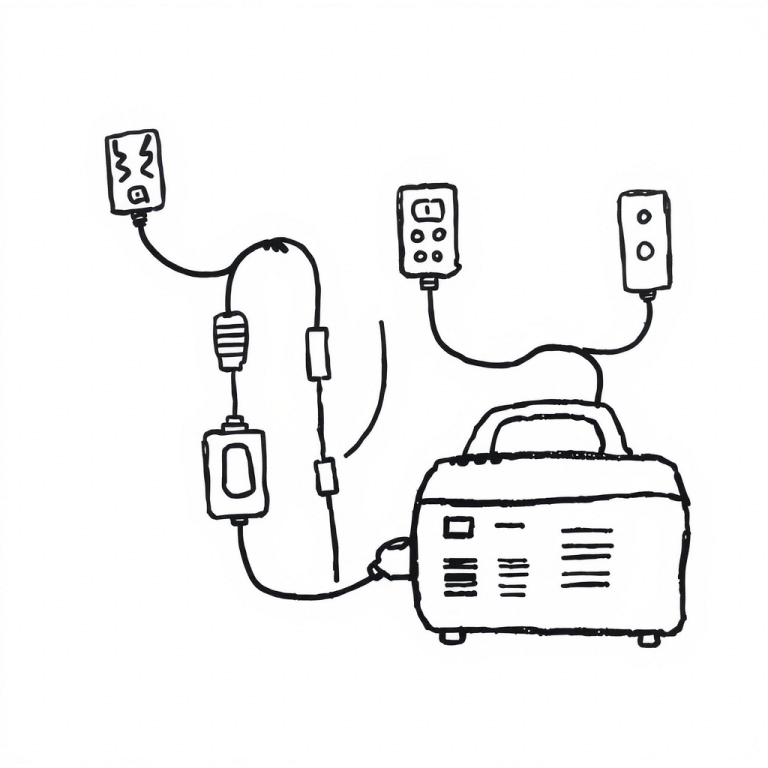How to Use a Portable Generator to Power Your Home Safely and Effectively
Power outages can happen unexpectedly due to storms, equipment failures, or even planned maintenance by utility companies. As a homeowner, being prepared for these situations is crucial, and a portable generator can serve as a reliable backup power source. However, using one requires careful planning, proper equipment, and strict safety measures.
In this guide, we’ll cover everything you need to know about selecting, setting up, and operating a portable generator to keep your home powered during an outage.
Why Use a Portable Generator?
A portable generator is a cost-effective alternative to a standby generator, providing electricity to your essential appliances and systems when the main power grid is down. Some key benefits include:
- Affordability: Portable generators are significantly cheaper than standby models.
- Flexibility: They can be moved to different locations as needed.
- Backup Power for Essentials: They can keep critical systems running, such as refrigerators, lights, communication devices, and medical equipment.
- Quick Setup: Unlike a standby generator that requires permanent installation, a portable generator can be set up as needed.
However, there are some limitations:
- Limited Power Supply: Most portable generators cannot power an entire home, so prioritization of essential appliances is necessary.
- Manual Operation: Unlike standby generators that start automatically, portable generators require manual setup and fueling.
- Regular Maintenance: They require frequent refueling, oil changes, and inspections.
Despite these limitations, a portable generator can be a lifesaver during prolonged outages—if used correctly.
Preparing for a Power Outage
1. Choose the Right Generator
Selecting the right generator is crucial to ensure you have enough power for essential appliances without overloading the unit. Consider these factors:
- Power Output (Wattage): Determine your home’s power needs by listing essential appliances and checking their wattage requirements. Most generators list both running (continuous) watts and surge (starting) watts.
- If your total essential load is 4,000 watts, choose a generator with at least 5,000 watts to allow for a safety margin.
- Fuel Type:
- Gasoline: Widely available but has a short shelf life.
- Propane: Burns cleaner but requires a separate tank.
- Diesel: More efficient but bulkier and louder.
- Dual-Fuel Generators: Can run on both gasoline and propane for greater flexibility.
- Noise Level: Some generators are quieter than others. If you live in a suburban area, a low-noise model may be a better choice.
- Portability & Durability: Look for models with wheels and handles if you need to move the generator frequently.
| Appliance | Running Watts | Starting Watts |
|---|---|---|
| Refrigerator | 600 | 1200 |
| Sump Pump | 750 | 1500 |
| Electric Stove | 1500 | 2000 |
| TV | 200 | 400 |
| Laptop | 50 | 100 |
| Lights (LED) | 10 | 10 |
2. Purchase Essential Equipment
To integrate a generator with your home’s electrical system safely, you’ll need:
- Transfer Switch: This is the safest way to connect a generator to your home’s electrical panel. A professionally installed transfer switch prevents backfeeding (sending electricity back into utility lines, which can be deadly to workers).
- Power Cords & Extension Leads: These should be:
- Heavy-duty (rated for generator use)
- Weatherproof
- Long enough to reach appliances safely
- Fuel Containers: Store extra fuel in approved, clearly labeled containers.
- Carbon Monoxide Detector: Since generators emit carbon monoxide, having a CO detector near sleeping areas can save lives.
3. Learn How to Use Your Generator
Before an emergency, practice setting up and running your generator:
- Startup and Shutdown Procedures: Follow the manufacturer’s instructions to ensure proper operation.
- Maintenance Routine: Regularly check oil levels, air filters, and spark plugs.
- Load Management: Learn how to distribute power among essential appliances without overloading the generator.
4. Fuel Storage and Management
Fuel is the lifeblood of your generator. Follow these best practices:
- Stock Up Safely: Keep enough fuel to last at least 24-48 hours.
- Storage Conditions: Store fuel in well-ventilated areas away from ignition sources.
- Fuel Rotation: Use older fuel first and replace it regularly to prevent degradation.
Steps to Take During a Power Outage
1. Setting Up the Generator Safely
- Move the Generator Outdoors: Position it at least 20 feet away from your home, ensuring proper ventilation.
- Connect to the Transfer Switch: If your generator is wired into your home’s electrical panel via a transfer switch, switch it to “generator mode.”
- Plug in Essential Appliances: Use heavy-duty extension cords to connect appliances directly to the generator if you don’t have a transfer switch.
2. Starting the Generator
- Follow the manufacturer’s instructions carefully.
- Let the generator run for a few minutes before plugging in appliances.
- Add Load Gradually: Plug in high-wattage devices one at a time to prevent overloading.
3. Monitoring and Managing the Generator
- Check Fuel & Oil Levels: Never let the generator run out of oil, as this can damage the engine.
- Listen for Unusual Noises: Strange sounds may indicate mechanical issues.
- Adjust Load as Needed: If you notice the generator struggling, unplug non-essential appliances.
Critical Safety Tips
Using a generator comes with risks. Follow these safety precautions:
- Never Run a Generator Indoors: Generators produce carbon monoxide, a silent killer.
- Keep It Dry: Do not operate in rain or snow without a cover or tent.
- Use a Transfer Switch: Plugging the generator directly into a home outlet can cause electrical fires.
- Refuel Safely: Turn off the generator and let it cool before refueling.
- Have a Fire Extinguisher Nearby: Keep an extinguisher rated for electrical and fuel fires close by.
- Do Not Overload the Generator: Running too many appliances can cause overheating or shutdown.
Post-Outage Procedures
1. Powering Down Safely
- Unplug Appliances: Prevent power surges when the grid is restored.
- Shut Off the Generator: Let it cool before storing.
- Switch the Transfer Switch Back to Utility Power: If using a transfer switch, return it to its normal position.
2. Maintenance After Use
- Drain Fuel (If Not Used Frequently): Prevents fuel degradation.
- Check for Wear and Tear: Inspect cords, plugs, and moving parts.
- Store in a Dry, Safe Location: Keep it ready for the next emergency.
Final Thoughts
A portable generator can be an essential lifeline during a power outage, providing critical electricity to keep your home running. However, it’s not as simple as plugging it in and turning it on. Careful planning, proper equipment, and strict safety measures are essential to ensure both efficiency and safety.
By choosing the right generator, preparing in advance, and following safe operating procedures, you can keep your home powered and protect your family during an outage. Always treat a generator as a temporary solution and report prolonged outages to your utility provider.
With the right preparation, you’ll never be left in the dark when the power goes out!



